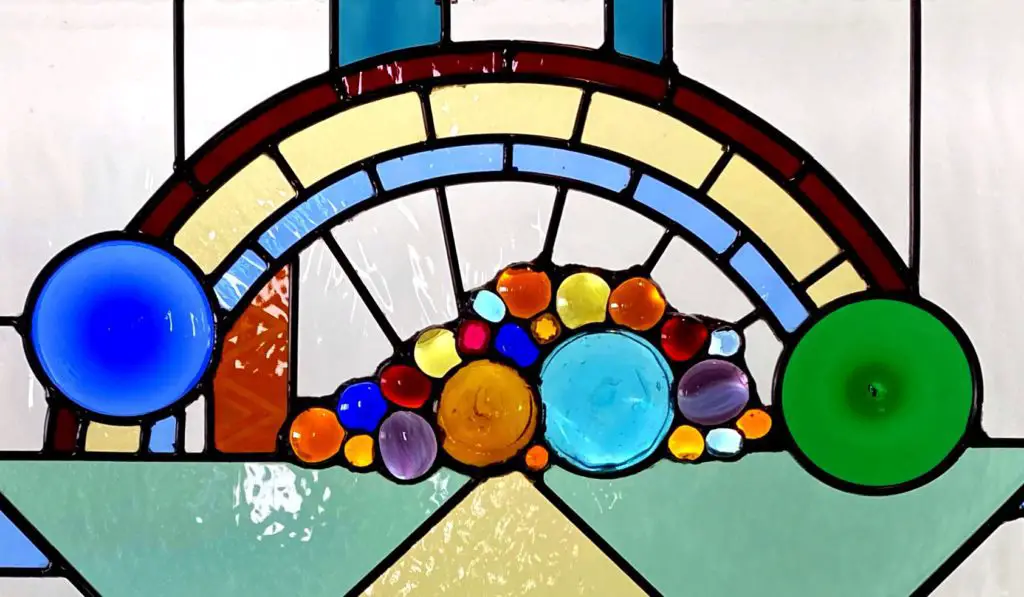Abstract stained glass uses shapes, colors, and lines to create designs that depart from a realistic depiction of the world.
Designs may be partially figurative or totally abstract: they frequently invoke a mood or stand for virtues like optimism or spirituality: they appeal to the sophisticated customer and, if designed expertly will, by avoiding the cliché, retain their exciting novelty.
Artistry in Glass has been designing abstract stained glass in Tucson since 1986 and has developed expertise in helping customers choose the best design for their home, company, or place of worship. This post explains the history of abstract stained glass and examples of the main design styles. Finally, as a service to customers and fellow glass artists, we detail eight examples of the ways we modify a realistic design and create an abstraction.
History of Abstract Art
Abstraction has occupied a primary place in the evolution of modern art since the early 1900s when radical changes were taking place in science, technology, and politics. These changes drove many leading artists away from the realistic depiction of life and towards the creation of a new type of art.
Take a look at these famous portraits to see how the visual arts evolved from figurative and highly realistic in the 17th Century (top row) to stylized and abstract in the late 19th to early 20th Centuries (bottom row).

A similar evolution in styles is found in liturgical stained glass: from Medieval realism (A) to neo-Gothic symbolism (B) to modern semi-figurative (C) and to total abstraction (D). Follow this link for more information on religious stained glass documentation and conservation.
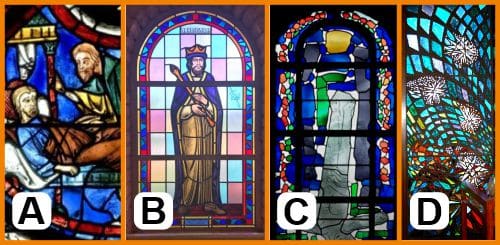
Medieval stained glass reached its peak in the magnificent Gothic cathedrals of the 12th and 13th centuries with figurative depictions of bible scenes such as those at Chartres (A). By the 19th Century, stylized but still realistic, images of saints characterized the neo-Gothic period (B). A unique renaissance of the glass arts flowered in post-WWII Germany where numerous churches were refurbished in abstract style by artists like Wilhelm Buschulte (C): notice that Christ is shown in recumbent and inverted cartoon-form. Finally, a new trend towards the entirely abstract is represented by a late 20th Century Dalle de Verre window (D).
.
Styles of Abstract Stained Glass
We summarise the techniques that can be used to modify a figurative design and change it into an abstract one. The idea is to surprise and delight the viewer – to introduce tension and uncertainty – to give her the opportunity to ponder the significance of the imagery. Eight examples of abstractions are explained below:
- Unexpected, non-realistic colors
- Unexpected, surprising lead lines
- Inspired by nature (leaves & plants)
- Inspired by nature (geological formations)
- Inspired by nature (the cosmos)
- Inspired by fine art
- Inspired by folk art (Hopi kachina)
- Inspired by technology (diagnostic machine)
- Inspired by total abstraction
Inspired by Unexpected Colors
All gradations occur from totally figurative to totally abstract and the novice may begin by taking a realistic image and challenging the viewer by changing colors from natural to unreal – or by changing a line from real to surreal. We’ll begin by changing colors:
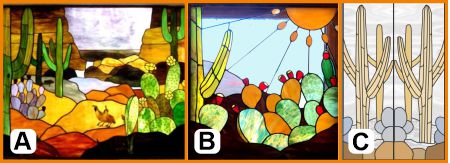
The simple step of surprising the viewer by using a non-realistic color is enough to change the design from a cliché to an interesting work of art. Let’s now take a look at how adjusting lead lines can create abstraction and extra interest.
Inspired by Unexpected Lead Lines
The evolution of the lead line
The lead line is the term used by glass artists to refer to the pattern of lines made by the metal (lead, zinc, or brass) came or even solder lines that serve to hold the glass together.
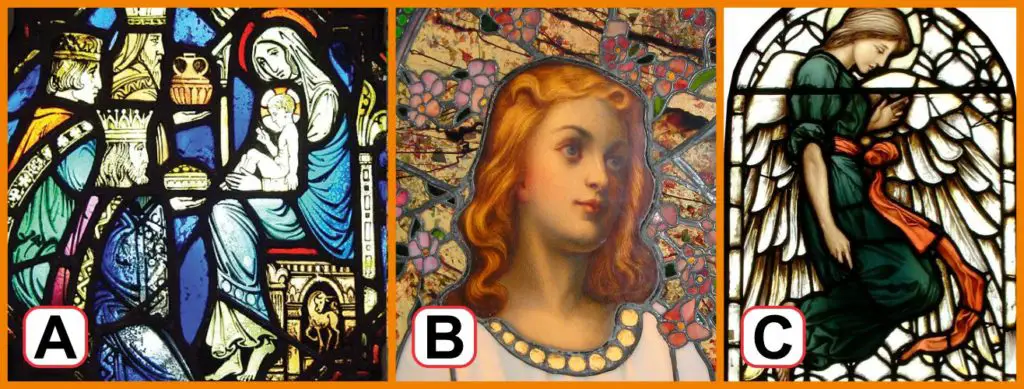
In early Medieval panels (A), lead lines were often discordant – crosscutting pictorial elements and serving only to hold the panel together. By the 19th century (B) lead was always arranged to surround important elements like face, while in the early 20th century, lead lines became important components of the design (see the feathers in (C) above).
Early leaded glass panels, made with diamonds and rectangles were called “Leadlights” but now the term stained glass is used to cover all types of leaded glass.
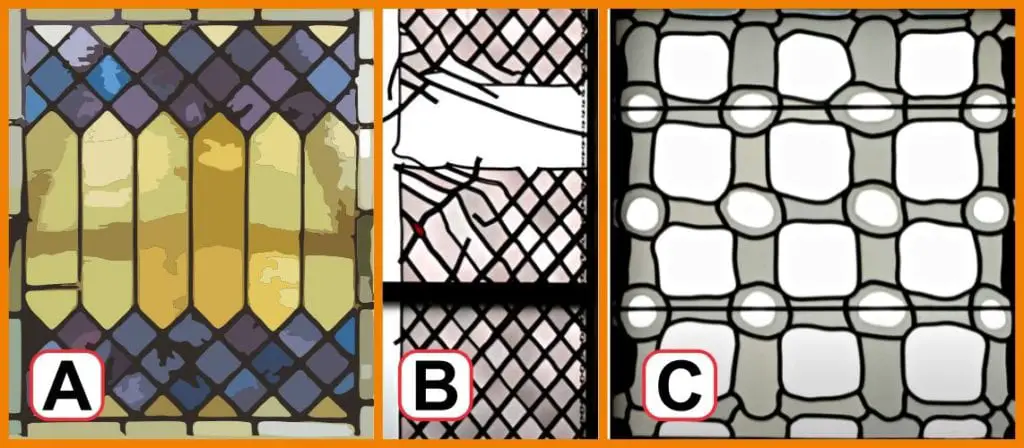
The same principle of abstraction used in color substitution is here used by surprising the viewer with unexpected lead lines. In (B) above the distorted and broken grid lines introduce a sense of drama to the panel. In the hands of German artist, Wilhelm Buschulte a design (C) that would historically have been made up of circles and squares is rendered by irregular, hand-drawn shapes giving a fresh liveliness to the panel.
Stained Glass Inspired by Nature: Leaves

Many of our clients at Artistry in Glass have a strong preference for either straight or curved lines. Curves relax the mind, providing relief, softness, and balance. They give a graceful, lyrical quality to interiors. In this example, simple leaves provide the inspiration for flowing abstract panels made from clear textured glass and installed as symmetrical mirror images in this interior door. The granite and water glass textures provide privacy for our customer’s home office.
Inspired by Nature: the Prairie Sumac

A wonderful classic from the Frank Lloyd Wright portfolio: highly abstracted Prairie Sumac plant is still recognizable even though rendered in characteristic and non-realistic straw & amber-colored stained glass
Stained Glass Inspired by Fine Art
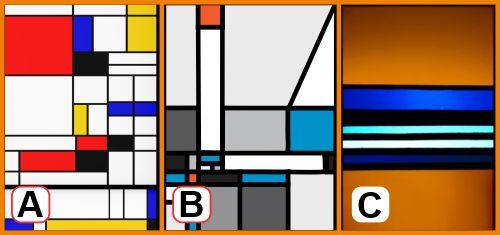
Of all the abstract movements, so-called “Hard-edge” art is particularly well suited to stained glass with strong primary colors and straight lead lines. Squares and rectangles (eg Mondrian-style (A & B) ) give us a sense of stability and safety, while horizontal lines (C) convey feelings of tranquility and a harmonious relationship with the earth. The skilled stained glass designer can draw inspiration from these famous works of art and design custom panels for the adventurous customer’s home.
Inspired by Geological Strata
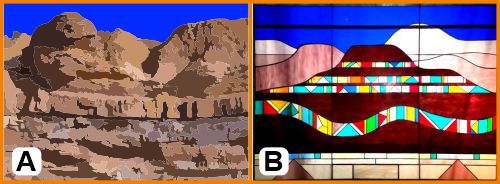
Playing with line and color, the artist surprises the viewer with multicolored and folded geological strata in an abstract cross-section through a southwestern mountain. Are the colors a little too vibrant and brash? You decide.
Inspired by Geological Faulting

Once again drawing inspiration from nature, a faulted section of strata imparts tension to the design that is partly resolved by the stabilizing effect of the horizontal and vertical beveled glass lines (representing igneous intrusions).
Stained Glass Inspired by Hopi Kachina
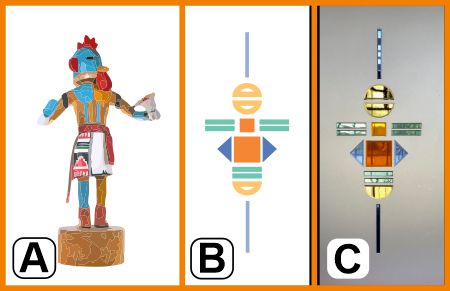
A traditional Hopi kachina provided the inspiration for this minimalist art glass panel. An almost complete abstraction, the design hints at the kachina shape while mirroring the color scheme. The art glass is realized by attaching polished and beveled colored glass to a frosted glass substrate using UV-activated adhesive.
Inspired by a Spiral Galaxy

Our customers were retired physics professors from the University of Arizona with a special interest in cosmology so we took as our inspiration the Andromeda galaxy. Our stock of antique glass, fortunately, included a mottled texture that closely resembled the cosmic microwave background as well as a special piece (B) that simulated a spiral galaxy with a black (blue) hole in the center.
Inspired by a Cancer Diagnostic Machine
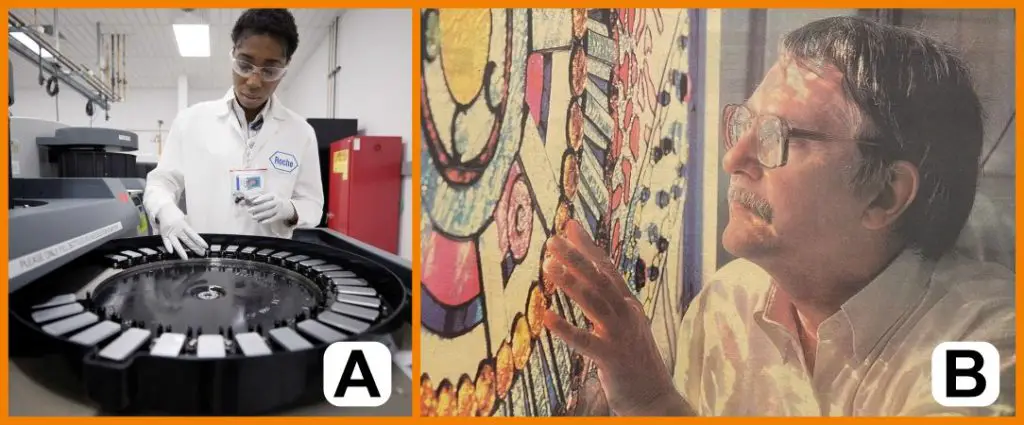
As a special gift to Ventana Medical Systems founder Dr. Tom Grogan, we construct an abstract rendering of an automated cancer diagnostic machine (invented by Tom). The microscope slides in our stained glass are represented by sparking beveled glass in a carousel arrangement. Ventana Medical merged with Swiss pharmaceutical giant Roche Holding AG in 2008.
Learn how our latest outstanding abstract panel was created and installed
Inspired by Total Abstraction
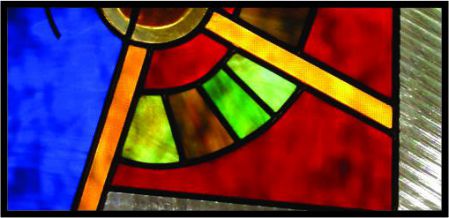
For the avant-garde customer – a total abstraction where circles compete with dramatic diagonal lines for drama. Dislocation of the circle creates tension. Colors are chosen to pick up highlights from a customer’s interior and mixed with bold textured glass (right) and trailing lead lines (top left).
Learn how this design was developed by following this short video:
Answers to Famous Artists Quiz

Top Row: artists painting in figurative/realistic styles
A : Diego Velázquez (1599-1660). B: Johannes Vermeer (1632-1675). C: Rembrandt van Rijn (1606-1669).
Bottom row: artists painting in impressionist/abstract styles
D: Vincent van Gogh (1853-1890). E: Henri Matisse (1869-1954). F: Pablo Picasso (1881-1973).
Conclusions
Tastes in art are very personal and highly subjective. Some customers are much happier with a realistic rendering of a Sonoran Desert scene, complete with saguaros and a coyote howling at the moon. If this is your taste, Artistry in Glass will attempt to accommodate you but, I have to confess that, our hearts will not be in the project. The main reason is that for all art – figurative or abstract, the main requirement is to avoid the cliché.
The second reason is that stained glass is not the ideal medium with which to render desert plants with complex flowers and thorns. Unless you make truly heroic (and expensive) efforts with glass painting and/or sandblasting, the results tend to look childish and naive – like Folk Art.
The benefits of abstract stained glass
There is no doubt that customers with the courage to think outside the box will benefit from a unique work of art when avoiding the figurative. Finally, if your tastes are stubbornly traditional then geometric/abstract designs in the Victorian, Baroque, or Art Nouveau styles (see below) are also very acceptable options
Traditional Non-figurative Designs

Strictly speaking abstract but nevertheless traditional and ideal for a conservative home. Should be made with period-appropriate opalescent glass.
Southwestern Chevron Designs
Also abstract in the sense that it is nonfigurative – this design is a variation on the Prairie style of Frank Lloyd Wright, adapted with strong Southwest-inspired colors.
Southern Arizona Customers – call Artistry in Glass!
For highly creative stained glass designs in contemporary and abstract styles – call John Wakefield at Artistry in Glass in Tucson or follow the links below for more information on how to order a stained glass masterpiece.
All you need to know about art glass
Commissioning stained and etched glass
- Stained glass designs from Artistry in Glass
- How to commission a stained glass window – complete advice
- How to commission an etched glass window
- How to choose the best stained glass design
- Etched or stained glass – which is better for your home?
- How much does stained glass cost?
- How much does etched glass cost?
Technical information
- Is leaded glass dangerous? Learn the facts.
- How to replace broken patio table glass
- Plexiglass and glass – what are the pros and cons?
- What is plexiglass used for?
- What costs more – glass or plexiglass?
- Preservation of stained glass in churches & synagogues
- How does stained glass get colored? learn from an expert!
- Is your broken stained glass panel worth repairing?
- How to protect stained glass in religious buildings
- How to care for and clean stained glass
- How to repair cracked stained glass
- What is Dalle de Verre?
- How to repair Dalle de Verre
- What to do about bowed & sagging stained glass
- How to care for a stained glass skylight
- Can my stained glass lampshade be repaired?
- What is the difference between sandblasting & etching?
- Obscure and frosted glass – all you need to know!
- How to save money when buying glass
- Glossary of important terms used in decorative glass
- 14 Ways to sell stained glass
- What is imitation or faux stained glass?
Guides to stained glass design
- Guide for designing abstract stained glass
- Why choose abstract contemporary stained glass
- How to design a Frank Lloyd Wright-style window
- Designing a WWII-era stained glass Waco glider
- Stained glass and Black Lives Matter
- How Is stained glass used today?
Artistry in Glass was your source for antique repair in Tucson
Check out this amazing selection of informative articles:-
- Where can I get antiques repaired?
- Are broken antiques worth fixing?
- How to fix a broken picture frame
- How to repair a broken china plate
- How to repair a broken china teapot
- How to fix a broken marble slab
- How to repair a broken china coffee mug
- How to repair a 2000-year-old sculpture
- All about repairing stained-glass lampshades
- How to care for your stained glass skylight
- How to repair Dalle de Verre
- Is stained glass worth repairing?
- To repair or toss out?
- Tucson crystal & china repair a division of Artistry in Glass
- What to do with broken antiques
- Is lead crystal dangerous?
- Repairing an antique Mexican statue
- Repairing religious statues
- The history of Swarovski crystal figurines
- How to find the value of a Swarovski Crystal figurine
- Have Swarovski crystal figurines lost value since 2009?
- How to collect Swarovski annual ornaments
- How to display Swarovski crystal figurines
- How to authenticate a Swarovski crystal figurine
- How to display Swarovski annual ornaments
- How to clean Swarovski crystal figurines
- How to repair a Swarovski crystal mouse
- How to repair a Swarovski annual ornament
- How to repair a Swarovski crystal train set
- Fixing broken wine glass stems
- How to clean cloudy glasses
- Why do wine glasses have stems?
- Swarovski Crystal Figurines
- How to repair a chip in a wine glass
- How to fix a scratched glass tabletop
- How to replace a broken patio tabletop

